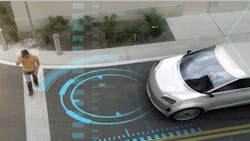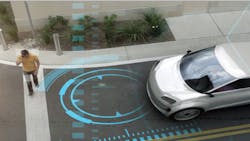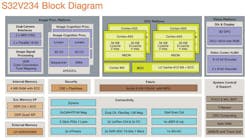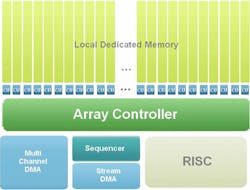When it comes to Advanced Driver Assistance Systems (ADAS), Freescale’s S32V234 ADAS system-on-chip (SoC) deserves a close look. I know it is targeted at automotive applications, but it would be really neat for other applications like robotics and UAVs.
All of these systems are starting to employ a wide range of sensors (Fig. 1). The Mark 1 eyeball is great, but it is getting a lot of help from these additional sensors. Every sensor, including the Mark 1, have advantages and limitations. Combined, they can exceed the capability and safety of the any single sensor.
The S32V234 ADAS is directed at high-performance automotive systems (Fig.2). It has four, 64-bit Cortex-A53 cores to host the main application. It also has a Cortex-M4 dedicated to peripheral management. The Cortex-M4 is designed to run AutoSAR AUTomotive Open System ARchitecture) software. All memory has ECC support, including off-chip memory.
The system is heavy on connectivity, too. It has a gigabit Ethernet interface; Zipwire; dual CAN-FD interfaces; four QSPI interfaces; an SD-HC interface; dual FlexRay; dual LinFlex; and x1 PCI Express lane. Security is also high on the feature list. It supports secure boot from a QSPI memory and it can store domain-security keys. There are also other goodies like lock-step DMA redundancy and hardware self-test that are key to implementing safe systems. The S32V234 targets ISO26262.
Now for the video stuff.
The system is designed to work with cameras. The inclusion of Cognivue’s APEX-2 Image Cognition Processor (ICP) with its image-processing technology is significant. It is essentially a GPU for handling incoming images versus the typical GPU used for handling displays. The S32V234 does have a Vivante GC3000 GPU that has surround-view support. This is the ability to knit together the input from four outward-facing cameras into a 360-deg., top-down view that essentially provides a driver with information about adjacent objects including cars, people, and pets.
It is Cognivue’s APEX-2 image processing (Fig. 3) that makes this platform stand out. Image processing, like image display processing, is specialized and heavy, computationally speaking. Cognivue provides an OpenCL programming interface like that found on GPUs.
The Computational Units (CUs) that operate in parallel have their own dedicated local memory. They can implement multiple filters in series, reducing memory access and system communication overhead. The APEX Core Framework (ACF) software handles filter dependencies and manages image data. The system has a massive data bandwidth while only using a couple hundred milliwatts of power, compared to a multicore DSP that would still be hard pressed to catch up when dealing with video data.
Freescale is partnering with a number of companies because of the range of features on the chip. For example, Green Hills Software supports its Integrity operating system on the S32V234 Cortex-A53 core. Neusoft Automotive has pedestrian recognition software that works with the APEX-2.
The S32V234 will be targeting applications like Autonomous Emergency Brake (AEB), Lane Departure Correction (LDC), and Pedestrian Protection (PD) that will employ sensor fusion (Fig. 4) as we move toward an automated vehicle. This includes integration of sensors like radar and cameras.
The S32V234 will be finding a home in high-end automotive solutions, although you will probably not have a Freescale (now NXP) logo on the dash. Still, you might be able to figure it out based on the features and performance of the ADAS system.
The S32V234 is designed for the long term. Freescale will be supporting it for at least 15 years. Freescale also employs a zero-defects methodology throughout the design, production, assembly, and testing.
About the Author
William Wong Blog
Senior Content Director
Bill's latest articles are listed on this author page, William G. Wong.
Bill Wong covers Digital, Embedded, Systems and Software topics at Electronic Design. He writes a number of columns, including Lab Bench and alt.embedded, plus Bill's Workbench hands-on column. Bill is a Georgia Tech alumni with a B.S in Electrical Engineering and a master's degree in computer science for Rutgers, The State University of New Jersey.
He has written a dozen books and was the first Director of PC Labs at PC Magazine. He has worked in the computer and publication industry for almost 40 years and has been with Electronic Design since 2000. He helps run the Mercer Science and Engineering Fair in Mercer County, NJ.
- Check out more articles by Bill Wong on Electronic Design
- Bill Wong on Facebook
- @AltEmbedded on Twitter




